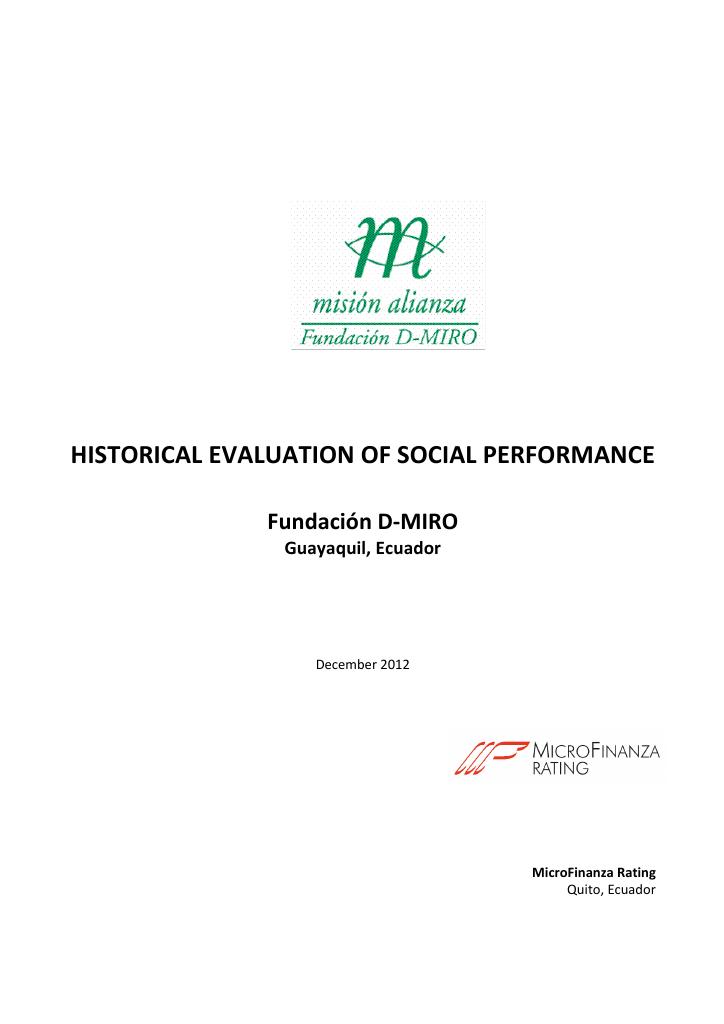Evaluering
Historical Evaluation of Social Performance – Fundación D-MIRO
Background: Mission Alliance started its microcredit activities 1997 with the Microcredit Program, Diaconía Micro Crédito Rotativo, D-Miro, with the intention of reaching the less-favored population in urban-marginal areas of the Isla Trinitaria, on the outskirts of Guayaquil, in the Province of Guayas. The program was funded by an international cooperation project under the responsibility of the Mission Alliance. In 2003 D-Miro started the process of becoming a foundation, which was completed on November 2006. The Foundation is positioned in areas of high density population and absolute lack of financial services and reaches a very high growth in assets, liabilities and portfolio. In 2009, D-Miro was in the third place among the top 100 institutions that offered microcredit, winning the Award for Excellence in Microfinance in the "best reach field ". After a long process, the Foundation has become a Microfinance Bank. Purpose/objective: Historical evaluation of social performance that includes an analysis of the following areas: Social performance management, outreach, quality of service and analysis of variations. Methodology: The analysis of changes in financial aspects of customers is based on databases provided by D-Miro. The database analyzed consists of 1576 borrowers that are active customers at the time of the evaluation with long history in the institution (from 2 to 20 cycles of credit): the base corresponds to 3.4% of total active borrowers in September 2012 and 11,804 loans, with an average of 7.5 cycles.The analysis of changes in socio-economic aspects of the clients is based on surveys made to a sample of new and old customers of D-Miro. The surveys were conducted with 180 new customers (first credit cycle) and 180 older clients (more than five credit cycles with D-Miro).The survey of clients, interviews and focus groups was conducted in the period 19th -30th of November 2012. Key findings: Focus on marginal sectors with loan services: D-MIRO generally demonstrates that a microcredit service can be developed in poor and insecure neighborhoods. Although the entire population cannot realistically have access to this type of service, there is significant demand and a continuously developing market. Complementarity of credit with other development programs: although D-MIRO demonstrates the need for professionalization of the micro credit service in its initial stages, the microcredit program has taken advantage of other complementary services to "enter" in communities and neighborhoods that are complex because of lack of security. Credit methodology adapted to the target population’s needs: with the intention of deepening outreach of the marginalized sectors without real guarantees, and based on the experience learned from another country, group methodology of village banks and solidarity groups have been introduced in the past, however, they ended up not adapting to the characteristics and culture of the target population, resulting in repayment problems. A bank can continue doing the work of the foundation and the program, and do it even better: D-MIRO proves that the legal form of intervention does not affect the institutional mission and its values. In particular, institutional transformation has allowed reaching better service (larger scale, increased efficiency, lower cost for the client, more varied offer of financial services), which represents a direct benefit for the target population. Stability in governance, one of the key factors to put the mission into practice: The permanence of a single "owner" during the entire process of institutional development has been one of D-MIRO’s main success factors. Training and loyalty of loan officers is a key to growing in line with the mission: considering the peculiarities of the sectors attended, as well as the growing competition and over-indebtedness levels in clients, these aspects have a strong impact on growth capacity of quality operations and in line with the mission. Recommendations: In the future, it is necessary to improve the clear and unambiguous definition of social objectives that are based on the mission declaration.The need to strengthen social performance management, develop specific strategies for each social objective, and identify a monitoring and tracking system of social performance is also evident.It is necessary to structure specific documents such as the Shareholders Agreement, focus and institutionalize values to protect the vision and mission of the institution.It is important to structure better policies for a more systematic monitoring of indicators, especially on a monthly basis, to ensure complete alignment with the institutional mission performance.The major challenges are related to staff turnovers (especially loan officers) - continue to focus on strengthening human talent management.Clarify the costs and benefits of additional services such as micro insurance services.Analyze strategies to improve the information system in relation to clients’ social information.Design savings products aimed at specific segments of the target population, such as seniors, children and families of migrants.Evaluate the possibility to increase the offer of micro-insurance services – to meet more specific needs of the sectors.Development of Loyalty Policies through preferential credit policies for customers.No specific guidelines regarding forbidden behavior that may harm customers have been given to internal and external personnel involved in the collection process and particularly during collection activities.
